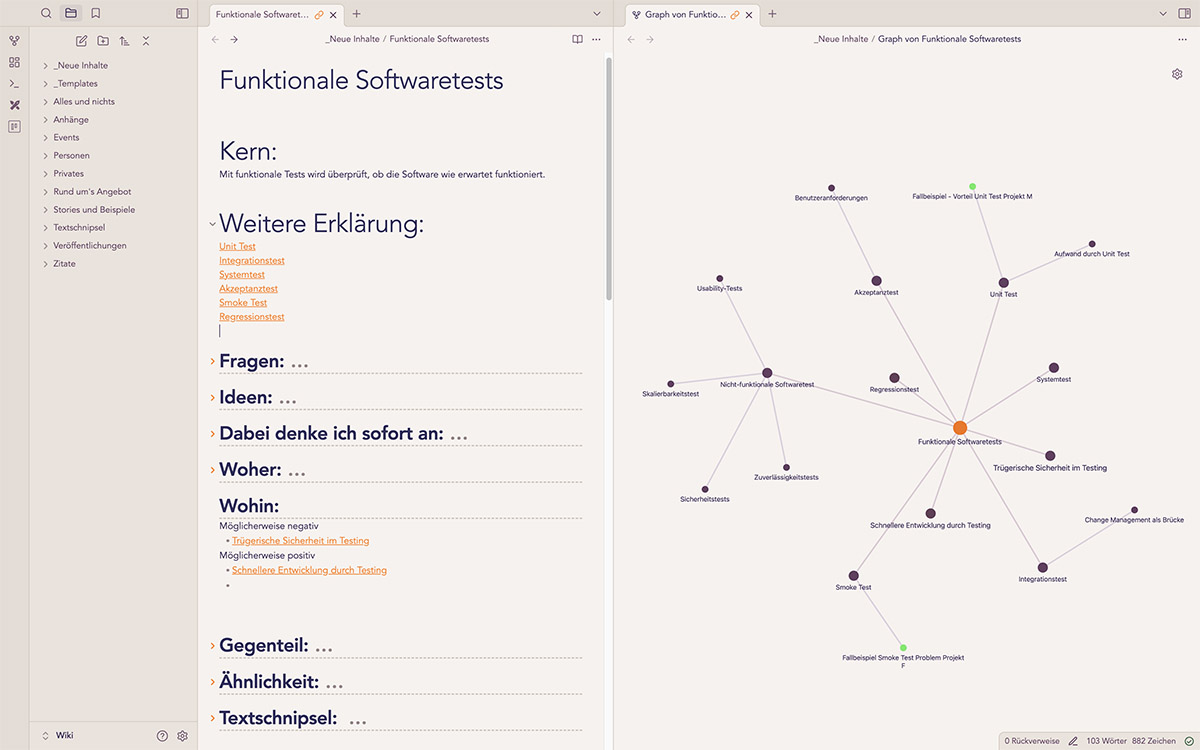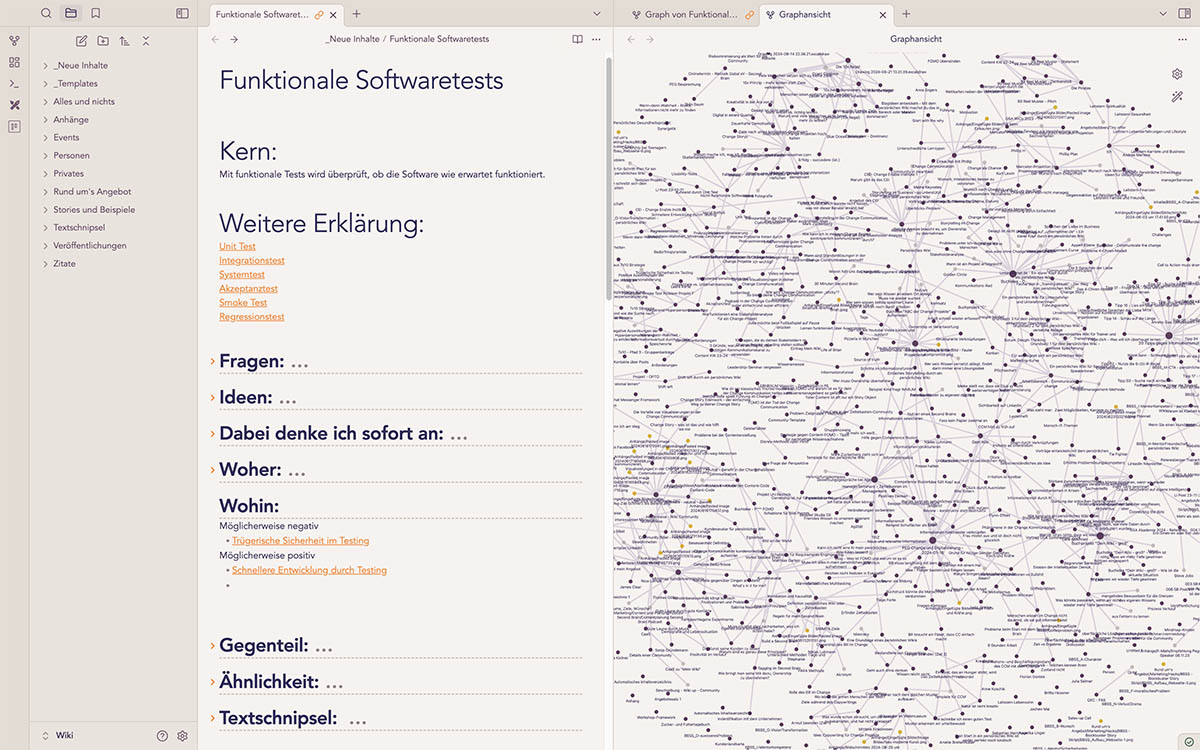A personal wiki for project managers
Capturing knowledge, maintaining an overview and sharing it with others – the demands on project managers are high. The first two points are often the first to fail, i.e. capturing knowledge in a structured way, storing it for the long term and maintaining an overview. With a personal wiki, project managers can visualise dependencies for themselves as a first step and also benefit from experiences from previous projects.
What is a personal wiki?
A personal wiki is a network of knowledge in which information is stored and linked together. So short, so simple.
The personal wiki has its origins in the card index of Niklas Luhmann, one of the best-known sociologists. His theories continue to be built upon and publications are still being generated from his card index even after his death.
He collected all information, ideas and initial elaborations in his card index (actually kept on paper and in card index boxes). With the help of a reference system, he linked these pieces of paper together, discovered new dependencies and came up with new ideas.
This approach is therefore interesting for anyone who often has the feeling of being flooded with information. However, the original note box was designed for scientific work, which is why it still needs to be adapted somewhat for use in companies and especially in projects.
The result is the personal wiki, which addresses the needs of people in business outside of scientific work.
The benefits of a personal wiki
Imagine that all the information available to you is laid out on a large tabletop in front of you. You can find any information immediately because you ‘only’ have to search for it on this one level. You no longer have to work your way through a deeply nested structure or many different filing locations.
If you can now filter out all information at a glance that contains the information ‘IT project’, for example, the amount will quickly become smaller and you will be able to find it more quickly.
And if they then start with any information, for example, and know that the internal links are guaranteed to take them to the information they are actually looking for, practically nothing can go wrong.
In short, a personal wiki makes life easier for people who work with knowledge.
How do you build your own personal wiki?
There are only a few principles that are important for a personal wiki and that you should bear in mind when setting it up.
Principle 1:
If you store your knowledge timelessly, you will still be able to work with it years from now.
When creating notes and adding them to your personal wiki, you should make sure that the information is prepared in such a way that you will still be able to understand it in the future. This means not only that you write legibly in handwritten notes, but above all that you can find the content again quickly.
Principle 2:
If you store your knowledge in a network, you will always find a solution.
From the outset, link the information you have stored with each other. ‘Which project does this information remind me of?’ or “How did we act in a previous project when we were faced with a similar situation?” can be suitable questions for the personal wiki in project management. It is ultimately up to you to decide which questions are relevant for you personally, i.e. which criteria you want to use to link information together.
Principle 3:
If you store your knowledge in one place, you will never have to search for it again.
The aforementioned metaphorical table makes this possible. Of course, you won’t want to keep your personal wiki on sheets of paper and on a table top. But the digital tool you choose will also be your ‘source of truth’, i.e. your storage location for all information.
The steps for your personal wiki are then straightforward:
Step 1:
Select information
Of course, you select the information you want to include in your personal wiki based on whether you think it is relevant and correct. The information should also be as small as possible. These so-called ‘atomic notes’ are added individually to your personal wiki. It is particularly important to record the information in small parts so that you can access and link to it individually later.
You know from your own experience how important this is and how little attention is paid to it: when we read a book, we quickly give the page in the notebook the title of the book as a heading and write down all the information that seems important or interesting to us one after the other. This way, however, we can only compare all the information in the book with all the information in another book later on. However, if we record the information piece by piece and immediately add a new note of our own to the comparison, an infinite number of possibilities open up.
An analogy is the search for a good pizzeria. If you are looking for a pizzeria in Munich, you have to tell your navigation system the full address to actually get there. It is not enough to enter ‘Pizzeria in Munich’ as your destination. If you are later in Düsseldorf and can compare the pizza there with the pizza in Munich, then this can only be done by direct comparison. It is rare that all pizzerias in Munich are better or worse than all pizzerias in Düsseldorf.
A good Atomic Note is therefore comparable to a good text: it’s just right when you can’t leave anything out.
Step 2:
Structure the information
You then structure the Atomic Notes in the same way. The best way to do this is to use a template. In this way, you first ensure that the information always has the same structure.
You will quickly discover your own personal structure. As a tip and first point of reference, I will show you roughly how I have structured my template for knowledge notes:
Core sentence:
The first point is the core sentence, i.e. the atomically small piece of information that describes everything and cannot be shortened any further. Ideally, it is even just a single sentence.
Further descriptions:
As soon as I realise that I may not understand the core sentence clearly later on, I add a short further explanation. This does not inflate the core sentence unnecessarily, but provides information quickly.
Links:
I have written down various questions and placeholders for the links between the sentences. This is the second major advantage of a template: you always have the option of creating structured links and are not dependent on chance. We will take a closer look at how these links are created in the third step.
Tags and keywords:
Tags offer the possibility of finding a piece of information again in different ways. You can select them according to the nature of the information, where or how you found it or to which larger topic it belongs, e.g. ‘History’, ‘LessonsLearned’ or ‘ProjectA’. You know best how your brain works and which keywords are best for searching and finding information.
Step 3:
Link information
The real gold of the personal wiki lies in the links between the information. Until now, we were dependent on the famous flash of inspiration that came to us while we were taking notes. It was only by chance that we remembered what we had already experienced in another project or what we had already written down somewhere else on this topic. With the corresponding catalogue of questions in the template, we can create structured links.
Links can be, for example, comparisons, past or future considerations. Examples of such questions are
Comparisons:
Comparison questions can help to learn from previous experiences or the experiences of others and derive solutions.
- In what context has this problem occurred before (and how did I solve it)?
- What similarities are there to a completely different area?
Looking at the past:
Looking at the past gets to the bottom of the causes without blaming others.
- How did this situation come about, what led to the current situation?
- What alternatives would have been possible?
Looking to the future:
Looking into the future helps to think outside the box and recognise possible dependencies for future scenarios.
- Where will the current situation lead if I continue to think about it (period x)?
- What still needs to happen for this expectation to materialise/not materialise?
Not that difficult, is it?
From personal wiki to team wiki
At first glance, it seems incredibly exciting to create a wiki and share it with the entire project team. It would be great if everyone could access the information and add to or update it themselves. Yes, that’s right. But there is a problem that is not so trivial to solve:
The more people involved in such a wiki, the greater the initial and ongoing maintenance effort. At the beginning, the team members have to clarify how they define an atomic note, what relevant knowledge is and what a template should look like. But the work doesn’t get any less during the ongoing project: exchanging information to ensure a common understanding, consistent links and clearing up dead ends or irrelevant information are necessary tasks. Most of these tasks cannot be accomplished if you only maintain your personal wiki and occasionally share it with others, e.g. in a team meeting.
So my tip: try out the personal wiki for yourself first. Then consider what added value it has when the whole team works on it or only provides input on a selective basis.
Conclusion
A personal wiki offers project managers a powerful approach for capturing knowledge in a structured way, networking it and making it usable in the long term. Through the targeted recording and linking of information, dependencies can be made visible and lessons learnt from past projects. However, before you attempt to transfer such a system to an entire team, you should first try out a personal wiki on a small scale. The three steps of selecting, structuring and linking information are particularly helpful here. This will allow you to evaluate and optimise the benefits for yourself and then start working with a team wiki if necessary.
Notes:
Would you like to organise your knowledge in a personal wiki? Then get in touch with Stephanie Selmer, either via her website, where you can find more interesting information about organising knowledge, or via LinkedIn.
If you like the article or would like to discuss it, please feel free to share it in your network. And if you have any comments, please do not hesitate to send us a message.
Stephanie Selmer has published more articles on the t2informatik blog, including

Stephanie Selmer
Strong companies do not only rely on new IT systems for their way into the future, but above all on their employees. Stephanie Selmer supports organisations in making changes, improving cooperation, achieving common goals and finding IT professionals. Her clients include medium-sized companies from all sectors who see digitalisation as an opportunity to empower their employees.





